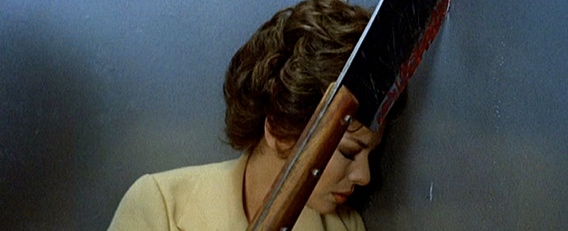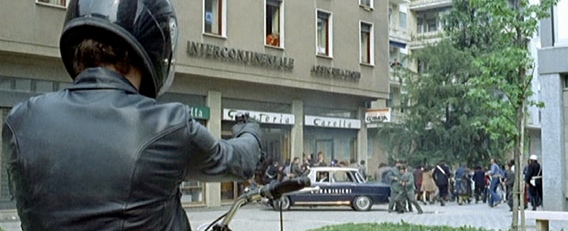
Whilst giallo had begun to dominate Italian cinema during the early seventies, another genre that had begun to attract attention was poliziesco, complex crime thrillers that, much like their more successful counterparts, had been inspired by the pulp novels of the thirties and forties. Often focusing more on the police investigation than the violence itself (unlike the works of Argento and Fulci), poliziesco would become popular with the likes of Carlo Lizzani’s 1968 drama Banditi a Milano (aka Bandits in Milan), although by the early seventies American thrillers such as Bullitt and Dirty Harry had lent a more sadistic and hardboiled tone to the genre. Notable directors of the poliziesco film would include Fernando Di Leo (particularly his ‘Milieu Trilogy‘ which consisted of Milano calibro 9, La mala ordina and Il boss), Umberto Lenzi (who, prior to achieving notoriety with Cannibal Ferox, would helm such popular thrillers as Il Giustiziere sfida la città and Napoli violenta) and Massimo Dallamano.
Born in Milan on April 17 1917, Dallamano would enter the film industry as a cinematographer on the 1946 drama Inquietudine (Anxiety). After making his own directorial debut in 1959 with Tierra mágica (which he would co write and direct with Vittorio Valentini, with scripting assistance from Elso Valentini), Dallamano would continued to work as a D.O.P. on a variety of successful flicks including Sergio Leone’s Per un pugno di dollari (A Fistful of Dollars, working under the pseudonym Jack Dalmas) and Per qualche dollaro in più (For a Few Dollars More). After flirting with both giallo (La morte non ha sesso) and softcore (Le malizie di Venere, more commonly known as Venus in Furs), Dallamano would finally enjoy box office success with his 1972 thriller Cosa avete fatto a Solange? (What Have They Done to Solange?).
Dallamano’s next feature would continue various themes explored in his previous effort, including a killer who targets schoolgirls, prompting many critics and fans to consider it a loose sequel. Released in 1974, La polizia chiede aiuto (What Have They Done to Your Daughters?) would begin with the discovery of the body of a young girl that later reveals a web of corruption and murder. Despite its controversial subject matter, Dallamano was suitably impressed with the premise by first-time writer Ettore Sanzò (who would later pen the equally disturbing L’ultimo treno della notte (Night Train Murders) and agreed to help adapt it into a workable screenplay. Utilising many traditions of the poliziesco, La polizia chiede aiuto would show the events from the point of view of the investigation, with homicide cop Inspector Silvestri leading the manhunt for the killer.
Despite being produced so soon after Cosa avete fatto a Solange? (and continuing the same themes), Dallamano would surround himself with a different crew this time around. Whereas his last effort had been lensed by the notorious Joe D’Amato (who would forge a filmmaking career of his own in both horror and softcore by heavily plagiarising more successful films, here working under the alias Aristide Massaccesi), Dallamano would instead hire Franco Delli Colli (who would later serve as Lamberto Bava’s cinematographer on Macabro). Replacing composer Ennio Morricone (who had received acclaim for his work on C’era una volta il West, L’uccello dalle piume di cristallo and Una lucertola con la pelle di donna for Leone, Argento and Fulci, respectively). One collaborator to return, however, was makeup artist Dante Trani.
With the Italian film industry suddenly finding success internationally, countless movies were produced throughout the sixties and seventies, often resulting in many of the actors appearing in several films a year. This meant that one giallo could feature several recognisable faces from similar genre pictures. Claudio Cassinelli, who would take the role of Silvestri, would later appear in such cult favourites as La montagna del dio cannibale (Prisoner of the Cannibal God) and Assassinio al cimitero etrusco (Scorpion with Two Tails) whilst co-star Franco Fabrizi would have a small part in Night Train Murders. Swiss actor Mario Adorf had entered the industry in the fifties, enjoying success during the next two decades with Ten Little Indians, The Bird with the Crystal Plumage and La corta notte delle bambole di vetro (Short Night of the Glass Dolls).
Another common feature of many Italian films is to cast an American or British actor in order to help market the movie in English-speaking countries. Thus, Dallamano offered a supporting role to Hollywood star Farley Granger, who had previously enjoyed a successful collaboration with master filmmaker Alfred Hitchcock on Rope and Strangers on a Train before forging a career in Italy with La rossa dalla pelle che scotta (The Red Headed Corpse), Qualcosa striscia nel buio (Shadows in the Dark) and Alla ricerca del piacere (Amuck). Slasher fans will also recognise him from his small but memorable role in Joseph Zito’s 1981 thriller The Prowler as Sheriff Fraser. Other actors who had or would later appear in popular Italian genre pictures included Cheryl Lee Buchanan (Zombi Holocaust), Marina Berti (Night Train Murders), Micaela Pignatelli (La chiesa) and Corrado Gaipa (Il boss).
Whilst his previous feature had been filmed in London, What Have They Done to Your Daughters? was shot on location in and around the city of Brescia, in the northern region of Lombardy. The subject matter of the movie (which would include such taboos as teenage prostitution) would cause controversy but the film was still a minor success and, whilst critics stated that it was inferior to its predecessor, as still regarded as a thought provoking and stylish thriller. The film, along with What Have They Done to Solange?, would also have an impact on the giallo formula, pushing the genre further from the exploitation of Una lucertola con la pelle di donna (A Lizard in a Woman’s Skin) and more into poliziesco territory. Whilst the likes of L’uccello dalle piume di cristallo (The Bird With the Crystal Plumage) had featured police investigations as a subplot, the main focus had always been on an innocent protagonist (usually a foreign artist) launching his own investigation to prove his innocence.
With What Have They Done to Your Daughters? being released in 1974, Dallamano would not see the impact his movies would have on the Italian film industry as, on November 4 1976, he would be involved in a car accident shortly after completing Quelli della calibro 38 which would claim his life. He was only fifty-nine years old. He was due to shoot the third in his loose trilogy, Enigma rosso (Rings of Fear), but the film would instead be directed by Alberto Negrin in 1978. Whilst What Have They Done to Your Daughters? is at times uncomfortable viewing (more in its subject matter rather than its depiction of it), it would become regarded as a classic and the image of its killer, who his victims whilst dressed in black and hiding his features behind a motorcycle mask, would later be an influence on Ken Hughes’ excellent 1981 slasher Night School.


2 Responses to SPAGHETTI SLASHERS – What Have They Done to Your Daughters?